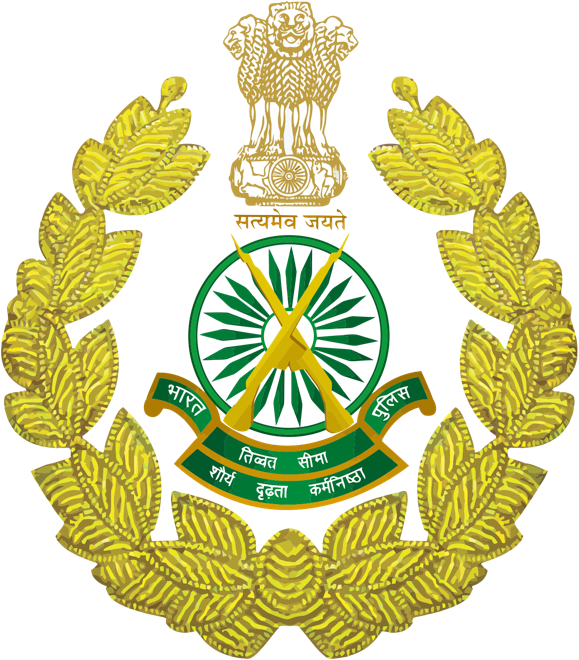SANSAD TV| National Security: Indo-Tibetan Border Police force

Disclaimer: Copyright infringement not intended.
Context
- ITBP has been guarding the India-China border in Jammu & Kashmir, Himachal Pradesh and Uttarakhand, Sikkim, and Arunachal Pradesh states from the Karakoram Pass in Jammu Kashmir to Jechap La in Arunachal Pradesh.
Details:
- The functions & tasks mandated include Vigil on the northern borders, detection and prevention of border violations, and promotion of a sense of security among the local populace.
- The ITBP Checks illegal immigration, trans-border smuggling and crimes and restores and preserves order in any area in the event of a disturbance.
- It is India’s Central Paramilitary Force, which is controlled by the Union Ministry of Home Affairs. Its primary mission is to protect the geopolitically and strategically significant Indo-China border, which it shares with the Indian army.
- ITBP Battalions are also providing security to various installations of national importance throughout the country, which includes Rashtrapati Bhawan, Vice President House, and various sensitive installations in Chandigarh (Punjab) Jammu (J&K).
- Because of increased Maoist activities in various parts of the Country, ITBP was inducted in District Rajnandgaon (Chhattisgarh) in December 2009 to thwart the Naxal menace.
- At present, 8 Battalions are deployed in Rajnandgaon, Narayanpur Kondagaon Districts of Chhattisgarh.
- Since 2015, the Kailash Mansarovar Yatra is also being conducted from the Nathula route and ITBP is providing similar assistance for pilgrims in this route also.
- ITBP conducts a large number of medical civic action programs in remote border and terrorist/naxal-affected areas to provide free and expert medical, health and hygiene care to the civilian population in remote villages.
MODIFY DETAILS
BACKGROUND/ORIGIN OF ITBP:
- Indo-Tibetan Border Police was raised on October 24, 1962 for reorganizing the frontier intelligence and security set up along the Indo-Tibetan border.
- Only four Battalions were sanctioned, to begin with. ITBP was initially raised under the CRPF Act. However, in 1992, parliament enacted the ITBPF Act and the rules there under were framed in 1994.
- With additional tasks entrusted to ITBP from time to time on border guarding, counter-insurgency and internal security roles, the number of ITBP Battalions increased gradually and ITBP presently has 60 service Battalions, 4 Specialist Battalions, 17 Training Centres and 07 logistics establishments with a total of strength of approx. 88,432 personnel.
- In the year 2004, in pursuance of GoM recommendations on “One Border One Force”, the entire stretch of the India-China Border comprising 3488 Kms was assigned to the ITBP for Border Guarding duty and, accordingly, ITBP, replaced Assam Rifles in Sikkim and Arunachal Pradesh in 2004.
| The motto of the Force is “Shaurya-Dridhata-Karma Nishtha”. |
Major Functions:
- Line duty: This is the most common role that ITBP personnel are assigned to and involves guarding the Indo-Tibetan border.
- Special duty assignments: These include deployments in disaster-affected areas, VIP security, and anti-naxal operations.
- Training: ITBP personnel are also responsible for training recruits.
- Administration: Personnel assigned to this role are responsible for the administrative functions of the force.
ITBP is divided into seven sectors, each of which is responsible for a specific section of the India-Tibet border. Within each sector, there are different types of ITBP roles.

Some of these roles include:
Surveillance:
- Surveillance officers are responsible for monitoring activity along the India-Tibet border. They use a variety of methods to gather information, including binoculars, night vision equipment, and unmanned aerial vehicles (UAVs)
Intelligence Gathering:
- Intelligence officers collect and analyze information about potential threats to Indian security. This information helps the ITBP to prevent and respond to cross-border threats.
Border Patrol:
- Border patrol officers patrol the India-Tibet border on foot and in vehicles. Their goal is to prevent people from illegally crossing the border and to apprehend those who do so.
Disaster Relief:
- When natural disasters or other emergencies occur, ITBP personnel are often called upon to provide assistance. They may help with rescue operations, providing medical care, or distributing supplies.
What are the challenges faced by ITBP?
Axis of Enquiry:
- The axis of examination is whether the ITBP is optimally positioned in its command and control, leadership, operational orientation, training, equipment and logistics for effective performance against the most likely major threats.
Old Arguments:
- At the meta-level, till now, the argument was that ITBP must maintain its police-heavy orientation, as the border was relatively peaceful and the various bilateral agreements in place did not warrant any change except in terms of improving the mechanisms for coordination with the Army.
- For obvious reasons, this line of argument can no longer hold water and the urgency for reform is obvious.
Nature of Change:
- In conjunction with the Army, defending territorial integrity and prevention of Salami Slicing is the highest form of threat that should shape the role of ITBP. This suggests a shift towards militarisation and calls for a move away from its police character.
- The question which arises is whether such a shift requires the grouping of the ITBP under the MoD instead of the MHA. If done, such a shift will also resolve the problem of two ministries, simultaneously being responsible for overlapping functions that increase the complexity of managing a sensitive border from which different forms of military challenges are likely to manifest and that which will demand speedy and effective responses.
- On the other hand, the prevailing configuration of dual responsibility is a recipe for failure.
Requirements of Border Defence:
- Ideally, border defence requires a force that plays the role of a tripwire, with the Army formations moving in swiftly to the critical areas to respond to situations as warranted. This demands synergy and cannot possibly be met by the existing arrangements.
- Depending on terrain, in some areas, the elements of the Army may play the tripwire role. It is now inevitable that considerable accretions in manpower, firepower and other warfighting elements/materials will have to be managed and deployed on the Himalayan border.
- Since China as a strategy would like to draw India’s resources towards its Northern border in an attempt to slow down India’s growth as a maritime power, India must manage the additional requirements by rebalancing some forces from the Western border as also by utilizing the ITBP battalions more effectively.
Army Linkage:
- The ITBP has 54 battalions, most of which are deployed all along the Sino-Indian border from Karakoram Pass in Ladakh to Jechap-La in Arunachal Pradesh.
- The sheer span of deployment is indicative that such a force is better integrated on a permanent basis with the Army.
- The limited police duties the ITBP has to undertake can be made up by collocating local police with sub-units

What are the suggestion and recommendations for the ITBP?
Guarding the borders:
- To manage the borders effectively, surveillance is carried out in the form of regular patrols by the border guarding personnel.
- In addition, several electronic surveillance types of equipment such as night vision devices, and handheld thermal is used by the border guarding forces as force multipliers for greater surveillance.
Regulation of the borders:
- Effective regulation of the borders involves the facilitation of legitimate trade and travel and the simultaneous prevention of ingress and egress of people and goods is an effective means of regulation that is employed at the borders.
Development of border areas:
- Difficult terrain and a lack of proper roads, educational institutions and hospitals keep the border areas inaccessible and underdeveloped. The resulting lack of economic opportunities makes the border population more susceptible to illegal activities such as drugs and smuggling.
Bilateral institutional mechanisms:
- Effective border management requires the facilitation of bilateral dialogue on matters of mutual concern, and thus, the Government of India has constituted a system of institutionalized interaction through the meetings of home secretaries, area commanders of border guarding forces and the joint working group on border management.
Mobilization and ordinance supply chain:
- The conventional use of technology in the context of border management pertains to the use of high-technology weapon systems including small arms, ammunition, combat vehicles and advanced communication.
- These investments ensure that we have the right triggers for mobilization and activating the ordinance supply chain so that our state of readiness is synergised with an emerging situation on the borders.

Conclusion
- All old arguments to maintain the status quo of ITBP have now been put to rest by China’s strategic exertions and India should be prepared for more problems to arise.
- Even if disengagement and de-escalation of the present crisis take place, the need for change endures, as the geopolitical rivalry is likely to get intense, as long as the boundary dispute and the global geopolitical tensions endure.
CITATIONS:
https://sansadtv.nic.in/episode/national-security-indo-tibetan-border-police-force-16-july-2023
https://www.itbpolice.nic.in/Home/htmnav
https://asiacentrebangalore.org/wp-content/uploads/2021/07/GPM_CLAWS.pdf
https://eurasiantimes.com/indian-tibetan-border-guards-hailed-for-their-valour-breaking-the-chinese-super-power-myth/
https://www.moneycontrol.com/the-winning-leap/resource/smart-border-management:-an-indian-perspective-september-2016/resources-1195.pdf?classic=true




